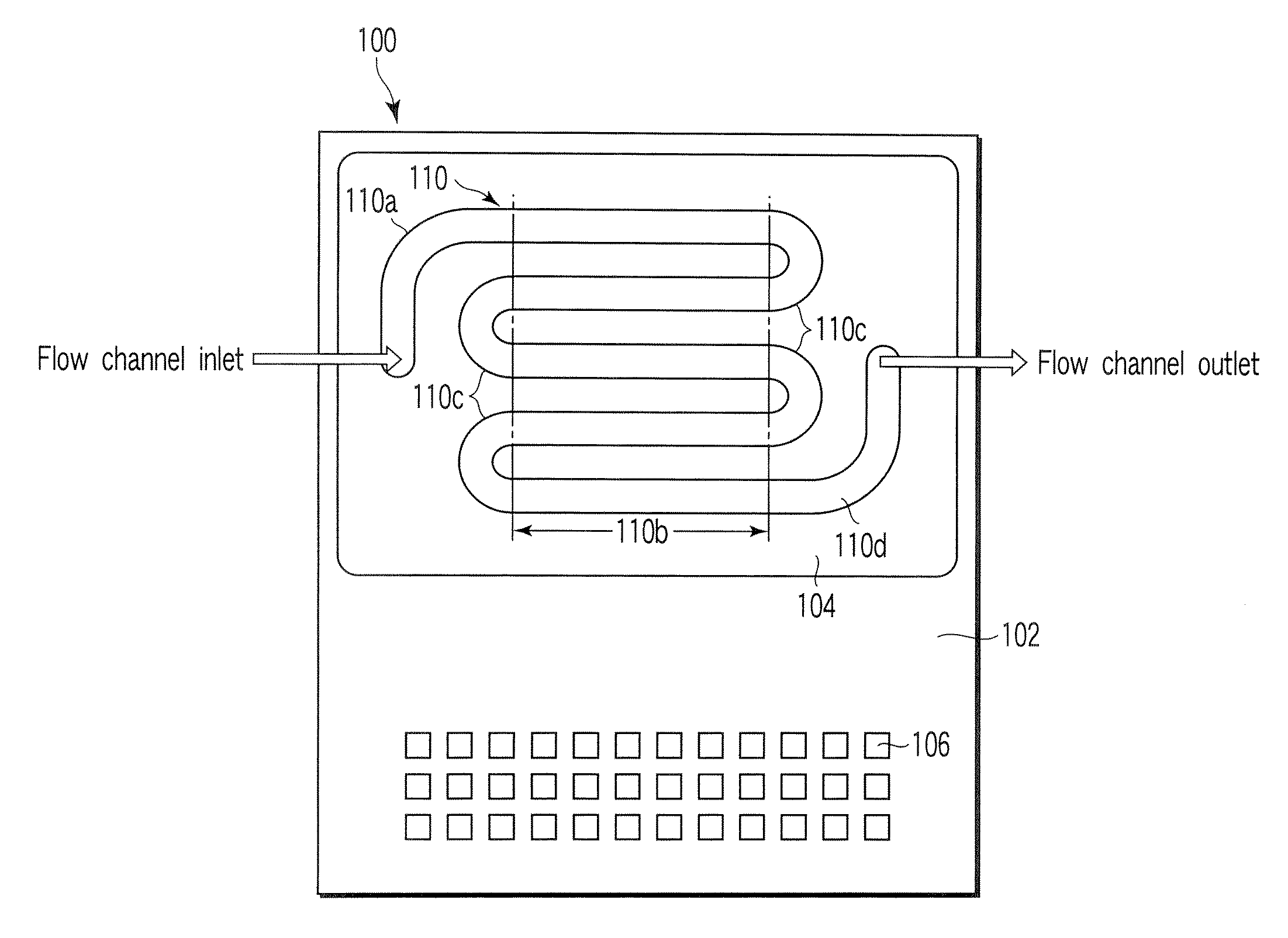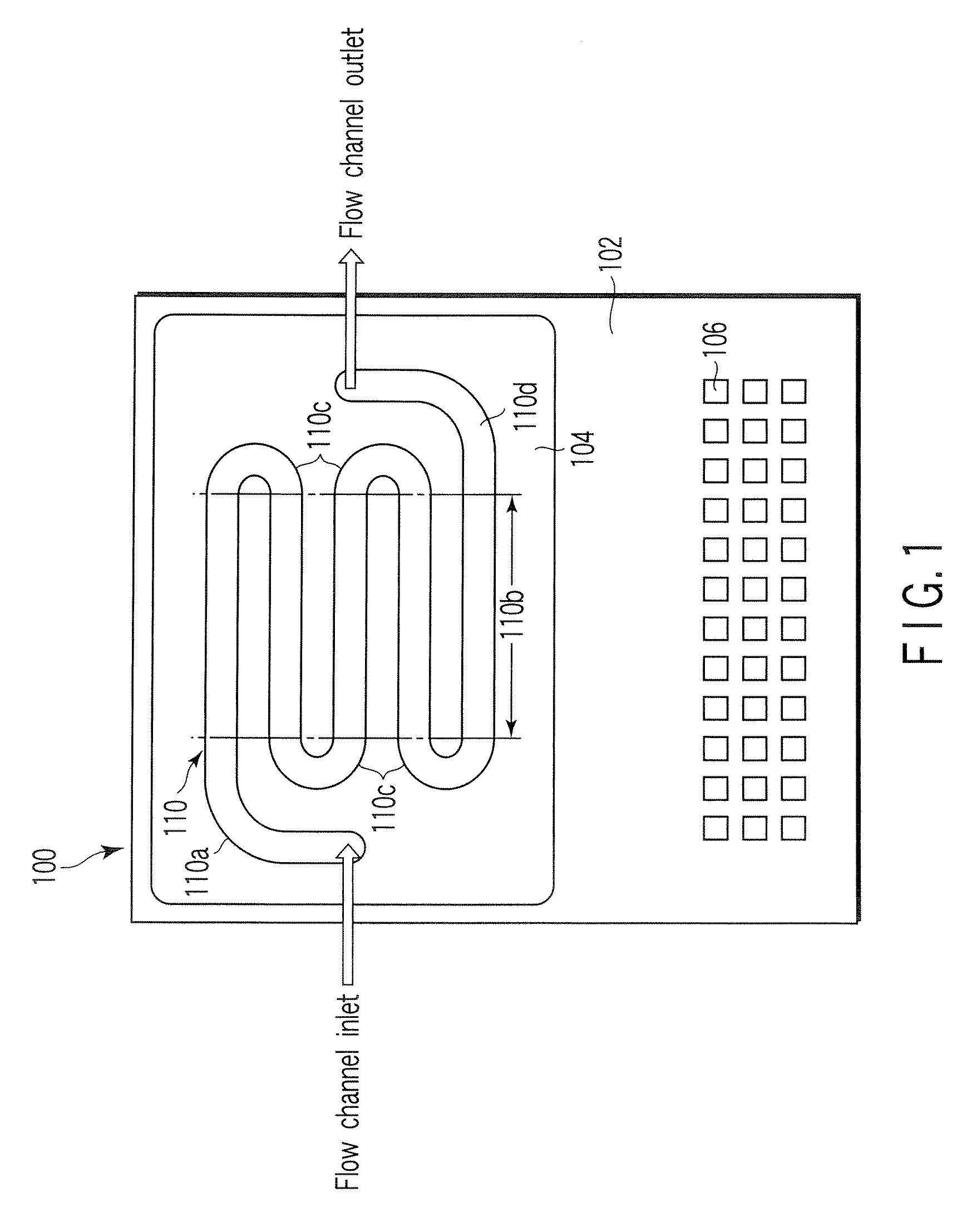Nucleic acid detection device
a detection device and nucleic acid technology, applied in the field of nucleic acid detection devices, can solve the problems of reducing detection accuracy, cumbersome operation, and requiring an expensive apparatus to detect fluorescent dyes,
- Summary
- Abstract
- Description
- Claims
- Application Information
AI Technical Summary
Benefits of technology
Problems solved by technology
Method used
Image
Examples
first embodiment
[0040]As shown in FIG. 4, a nucleic acid detection device 100 according to this embodiment has probe electrodes Ep and auxiliary electrodes Er. All the probe electrodes Ep are arranged at straight portions 110b. In other words, the probe electrodes Ep are arranged so as to avoid curved portions 110c. The auxiliary electrodes Er are arranged at the two ends of the row of the probe electrodes Ep located on each straight portion 110b and among the probe electrodes Ep.
[0041]Although the probe electrodes Ep and the auxiliary electrodes Er are arranged at regular intervals, they need not be arranged at regular intervals, but may be arranged at irregular intervals.
[0042]The auxiliary electrodes Er located at the two sides of each row of the probe electrodes Ep are located outside the corresponding straight portion 110b. Namely, the auxiliary electrodes Er at the two sides are located at the flow channel inlet 110a, the curved portions 110c, or the flow channel outlet 110d.
[0043]In this nu...
second embodiment
[0056]As shown in FIG. 10, a nucleic acid detection device 100 according to this embodiment has probe electrodes Ep and auxiliary electrodes Er, as in the first embodiment. All the probe electrodes Ep are arranged at straight portions 110b. The auxiliary electrodes Er are arranged at the two ends of the row of the probe electrodes Ep located on each straight portion 110b.
[0057]In this embodiment as well, preferably, the probe electrodes Ep are arranged so as to avoid the curved portions 110c and the upstream ends of the straight portions 110b that are located within a distance L from the downstream end of the curved portion 110c.
[0058]The auxiliary electrodes Er are located outside the straight portions 110b. More specifically, the auxiliary electrodes Er on the two sides are located at the flow channel inlet 110a, the curved portions 110c, or the flow channel outlet 110d. The auxiliary electrodes Er may be located at the portions of the straight portions 110b that are within the ...
third embodiment
[0063]As shown in FIG. 11, a nucleic acid detection device 100 according to this embodiment has probe electrodes Ep and auxiliary electrodes Er, as in the first embodiment. All the probe electrodes Ep are arranged at straight portions 110b. More preferably, the probe electrodes Ep are arranged so as to avoid the curved portions 110c and the upstream ends of the straight portions 110b that are located within a distance L from the downstream end of the curved portion 110c.
[0064]The auxiliary electrodes Er are arranged so as to avoid the straight portions 110b. Hence, the auxiliary electrodes Er are located somewhere within the flow channel inlet 110a, the curved portions 110c, and the flow channel outlet 110d.
[0065]The auxiliary electrodes Er located on the left side are commonly connected to one auxiliary electrode pad 106r through one auxiliary electrode wiring 108r. Similarly, the auxiliary electrodes Er located on the right side are commonly connected to another auxiliary electr...
PUM
| Property | Measurement | Unit |
|---|---|---|
| Flow rate | aaaaa | aaaaa |
| Distance | aaaaa | aaaaa |
| Electrochemical properties | aaaaa | aaaaa |
Abstract
Description
Claims
Application Information
 Login to View More
Login to View More - R&D
- Intellectual Property
- Life Sciences
- Materials
- Tech Scout
- Unparalleled Data Quality
- Higher Quality Content
- 60% Fewer Hallucinations
Browse by: Latest US Patents, China's latest patents, Technical Efficacy Thesaurus, Application Domain, Technology Topic, Popular Technical Reports.
© 2025 PatSnap. All rights reserved.Legal|Privacy policy|Modern Slavery Act Transparency Statement|Sitemap|About US| Contact US: help@patsnap.com



